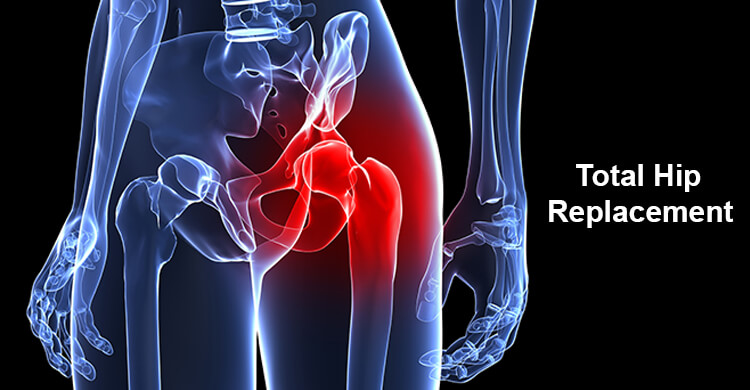
What is Hip Arthritis?
In simple terms, arthritis is damage of the joint due to inflammation. Hip joint is most commonly affected joint after knee joint.
What are the causes of hip joint arthritis?
What are the causes of hip joint arthritis?
It is related to the aging process and typically occurs in older individuals. The exact reason is unknown but many underlying factors have been identified
• Excessive body weight
• Faulty habits leading to abuse of the joint
• Hereditary factors
• Female gender
• Repeated High Impact Sports Activity
Secondary osteoarthritis:
Secondary arthritis of the hip joint is more common than primary arthritis. Most common causes are as following
• Avascular Necrosis of the femoral head
o Primary idiopathic Avascular Necrosis
o Post-traumatic Avascular Necrosis
• Fractures of Acetabulum or femoral head and neck
• Ankylosing Spondylitis
• Old infection of the hip joint such as tuberculosis
• Repeated synovitis due to Rheumatoid arthritis or Gout
• Previous neglected trauma
• Childhood causes such as developmental defects in hip joint (Hip Dysplasia)
What are the symptoms of hip arthritis?
• Hip pain, more in walking and crossed leg sitting; pain typically starts from the first step
• Limping is often the first and foremost symptom
• Shortening of the limb
• Tenderness around the joint
• Stiffness, particularly marked in morning
• Restricted movements of the hip joint
What is the underlying damage in hip arthritis?
There is breakdown of the shiny smooth cartilage, which lines the ends of the bone within the joint. These leads to denudation of underlying bone and pain.This damage to the cartilage is irreversible.
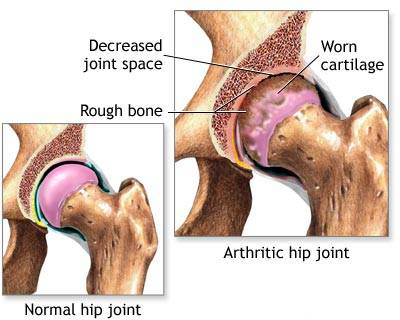
How the arthritis is diagnosed?
In addition to symptoms and physical examination findings, the diagnosis of arthritis is further confirmed by standard X-rays of the hip joints. In cases when X-rays are normal and hip pain is persistent, an MRI may be useful for detecting early changes of avascular necrosis of the hip joint.
Apart from that, secondary inflammatory arthritis and ankylosing spondylitis is diagnosed in blood tests.
What are the treatment options for Hip Arthritis?
Treatment options for Arthritis of the hip joints depend upon the cause as well as severity of the disease. Conservative management is ideal for all early cases of hip arthritis except avascular necrosis.
What are the modalities of non-operative treatment of knee arthritis?
There are four main modalities:
A. Avoidance of unnecessary stresses over the joint
• Weight loss
• Restriction of activities to avoid pain and further damage such as prolonged standing and walking, squatting and crossed-leg sitting
• Activities such as swimming or cycling are encouraged to keep active and maintain fitness and weight loss
B. Strengthening of the muscles around the hip joint
• Exercises to improve muscle power surrounding the hip joint at home
• Physiotherapy sessions to improve the strength by a trained doctor
C. Medicines
• Occasional use of pain-relieving medicines during phases of sudden severe pain
What are the options of surgical management of hip arthritis?
The main surgical treatment for hip arthritis is total hip replacement surgery. In early cases of avascular necrosis and non-union of fractures of femoral head; an attempt to preserve the natural hip joint may be carried out.
Total Hip Replacement (THR)
This procedure is ideal for you if you are
• Having advanced stage of arthritis
• Pain is not relived with medicines and physiotherapy and affects your daily routine
How it Is done?
• The hip joint is opened from the back of your buttocks and the head of femur is taken out.
• The damaged head of femur is removed at a pre-planned level. The socket of the hip is also prepared in spherical manner with special reamers to remove all diseased cartilage.
• The artificial socket is inserted at specific angle and occasionally fixed with screws.
• Same way, the cavity in the thigh bone is also prepared and a stem is inserted within.
• Movements and stability of the hip joint is checked and the wound is closed.
• Good quality imported implants are likely to last more than 20 years
We perform the surgery via minimally invasive approach where the muscles around your hip joint are minimally damaged or cut leading to faster and complete recovery without any need of physiotherapy.
What are the different types of implants used?
• There are wide variety of hip implants used in hip replacement
o Types of Acetabulum
Uncemented
Cemented
o Types of Femoral Stem
Uncemented
Cemented
o Types of Liner
Plastic: Basic liner made of high quality hard plastic
Ceramic: Long lasting
Constrained: In special cases where chances of dislocation are high
Metal: Rarely used now
o Types of Femoral Head
Metal: Basic head made with highly polished surface
Ceramic: Long lasting made of special ceramic material
o Size of Femoral Head
Femoral heads come in various sizes; 22 mm, 28 mm, 32 mm, 36 mm and 40 mm
With larger heads, more movement is possible and chances of dislocation are less.
What are the differences between cemented and uncemented implants?
| Type | Uncemented | Cemented |
|---|---|---|
| Material | Metal with special coating | Plastic/Metal |
| Bonding | Easy | Hard and cumbersome |
| Removal | Type of implant used | Plastic/Metal |
When will I be able to walk?
• In majority of the cases, you will be able to walk the very next day of surgery.
• However, depending upon the severity of the disease in certain advanced cases; you may not be allowed to put weight on the operated side for a period of three weeks.
• However, you will also be able to bend your hip and knee immediately after surgery.
When will I be able to go home?
• We will teach you walking with minimum support on the second day with exercises to do at home. Bending of the replaced hip is increased on second day.
• We will teach you to climb the stairs up and down on the third day and you will be able to walk without any support on this day in majority of the cases.
• We will change the dressing and you will be able to go home on the 3rd day itself.
What will be further treatment after surgery?
• You will be required to come for dressing at regular intervals till the stitches are removed.
• You will be able to resume all your household duties from the day you are discharged as per your comfort and recovery.
What is the time of total recovery?
Total recovery time varies from patient to patient and depends upon various factors
| Patient related Factors | Surgeon Related Factors |
|---|---|
| Amount of damage to the joint before surgery | Meticulousness and skill of the surgeon |
| Strength of your ligaments before surgery | Appropriate balancing of your joint |
| Power in your muscles before surgery | Type of implant used |
| Age | Whether the muscles were cut or not during the surgery |
| Toughness of your bones | Experience of the surgeon |
Total period of recovery ranges from 1 month to 2 months in majority of the cases; however, you will be getting more and more improvement till 100% recovery around 6 months.
What precautions do I need to take after a successful surgery?
• We advice to keep both legs apart from each other during initial period after surgery.
• Turning into the bed with affected side below the body is not allowed for at least 12 weeks.
• You may use an indian toilet and sit crossed leg after 12 weeks of the surgery. However, there are tremendous stress over you hip joint during such activities and they should be avoided as much as possible to improve the life of your artificial joint.
Hip Preservation Surgeries
In certain cases, an attempt to preserve the natural hip joint is done. This procedure is ideal for you if you are
• Less than 40 years of age
• Having grade I or grade II avascular necrosis of the femoral head or
• Having early signs of non-union of femoral fracture
• The sphericity of the femoral head is preserved
What are the different surgical options?
Depending upon the indication, following surgical options are available:
1. Core Decompression-
Early cases of Avascular Necrosis of Femoral Head
How it Is done?
An MRI is done to confirm the stage of the disease and assess the exact location of the diseased bone within the head
Hip joint is opened from thigh through a small incision and multiple wires are passed from the outer side of your hip bone to the diseased areas of the head through the neck of the femur.
Drill holes are done over these wires to remove the dead bone from the diseased area.
In many cases, a piece of bone(fibula) is removed from your leg and kept as a structural support in one of the holes.
When will I be able to walk?
You will be able to walk the next day of surgery with the help of a walker. You will not be able to put weight on your leg for six weeks.
When will I be able to go home?
You will be able to go home on the third day of surgery.
What will be further treatment after surgery?
• You will be required to change dressings at regular intervals till stitches are removed.
• Special exercises and knee bending is allowed after 3 days of surgery.
• You will be able to walk without support after three months of surgery.
What are the advantages?
• Preservation of natural hip joint
• Feeling of a more “normal” hip.
• All activities are possible without any limitation
What are the chances of success?
• The success of the surgery depends upon how early the disease is diagnosed and how early the surgery is done.
• As your bone is getting dead day-by-day, earlier the surgery, better the chances of recovery.
• According to journals, the success rate of this surgery is almost 70% if done in second stage and as high as 90% if done in first stage.
2. Valgus Osteotomy with or without muscle pedicle graft-
Early cases of Non-union of femoral neck fractures
This procedure is ideal for you if you are
• Less than 55 years of age
• Having neglected fracture of neck of femur within last 3 months or
• Having been operated for the same within last three months with signs of non-union
An MRI of the hip joint is often done to assess if there are any problems with the blood supply of the femoral head.Special X-ray is taken and an angle is calculated for exact amount of correction.
How it Is done?
A cut is made in outer aspect of your thigh and the thigh bone below the hip joint is cut. Previous implants if any are removed. A piece of a pre-determined thickness is removed from the thigh bone and the leg is angled outwards to close the gap. The cut is secured with special plate and screws above and below the cut.
This type of surgery will cause the old fracture in your neck to sit transversely so that there is compression over the old fracture when you will start walking. This force helps in early union of the fracture.
If the MRI revealed areas of bone necrosis, a special procedure to resume the blood supply from adjacent muscles is also carried out simultaneously.
When will I be able to walk?
You will be able to walk the next day of surgery with the help of a walker. You will not be able to put weight on your leg for 4-6 weeks.
When will I be able to go home?
You will be able to go home on the third day of surgery.
What will be further treatment after surgery?
• You will be required to change dressings at regular intervals till stitches are removed.
• Special exercises and knee bending is allowed after 3-5 days of surgery.
• You will be able to put some weight on your operated leg after 6 weeks of surgery.
• You will be able to walk without support after three months of surgery.
What are the advantages?
• Preservation of natural hip joint
• Feeling of a more “normal” hip.
• All activities are possible without any limitation
What if I am having continuous pain / limping after my hip replacement?
There are many causes of continued pain and limping after a hip replacement.Apart from lack of exercise, major reason for the continued pain is due to a failed hip replacement.
What are the causes of Failed Hip Replacement?
The reasons for the failed replacement may be due to faulty surgery or due to certain post-operative problems not related to the surgical technique
Fault in Surgical Technique
1. Malpositioning of the implants
2. Poor selection of implants
Post-operative Complications
Problems in the early or late post—operative period also lead to failed hip replacement
1. Infection- Either during surgery or due to spread from the body
2. Loosening – Leading to de-bonding of the implant from the bone
3. Wear – as the polyethylene bearing wears down, the hip can become increasingly unstable
4. Dislocation
How the failed hip replacement treated?
• You need to undergo a careful assessment of the causes of failure with an specialist surgeon. You may need to undergo a series of blood reports as well as X-rays/ CT scans also.
• Once the cause of the failure is identified, a revision hip replacement surgery is the ultimate solution.
• You may need to undergo more than one surgery for a long-lasting and successful treatment.
Actual patient
Primary Total Hip Replacement (Primary THR)
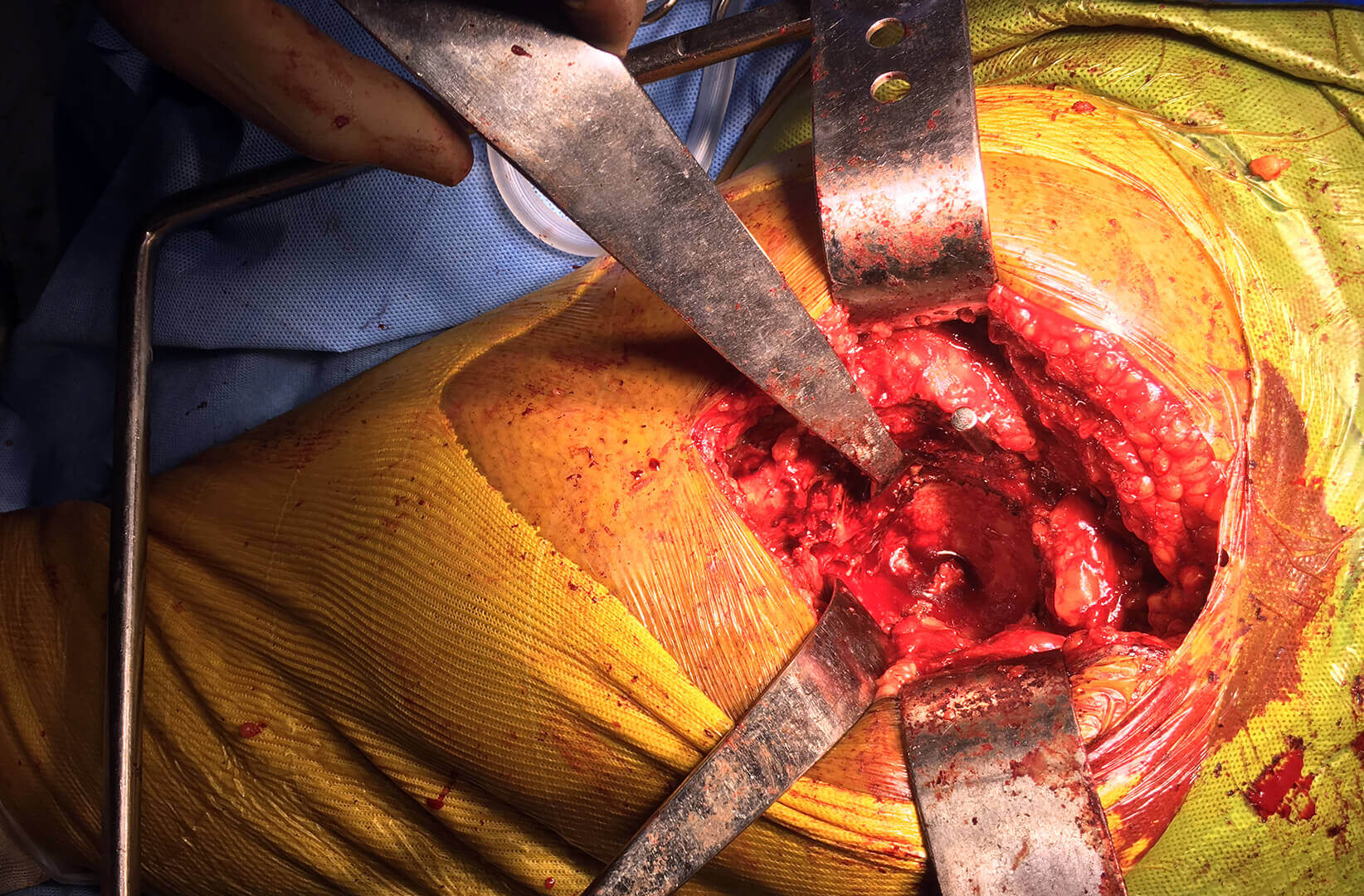 Intra-operative 360 degree view of acetabulum
Intra-operative 360 degree view of acetabulum
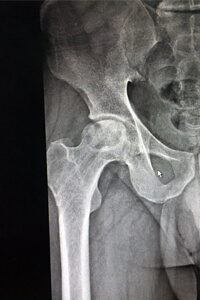
Pre-operative X-ray
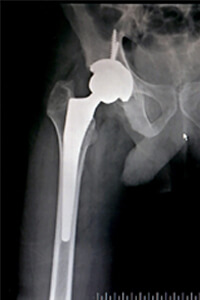
Post-operative X-ray
Actual patient
Revision Total Hip Replacement (Revision THR)
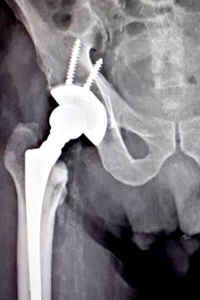
Immediate Post-op X-ray
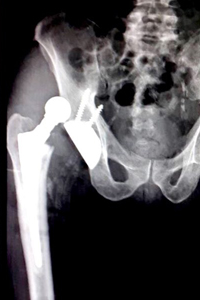
Dislocation due to stem loosening
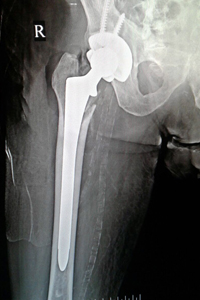
Revision performed with Uncemented Long Stem and Constrained Liner